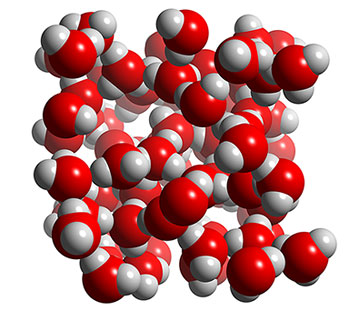Statistical Mechanics 1
Leo Lue
Department of Chemical & Process Engineering
University of Strathclyde
Statistical mechanics
Ludwig Boltzmann, who spent much of his life studying statistical mechanics, died in 1906, by his own hand. Paul Ehrenfest, carrying on the work, died similarly in 1933. Now it is our turn to study statistical mechanics. Perhaps it will be wise to approach the subject cautiously.
(Opening lines of "States of Matter", by D.L. Goodstein).
Statistical mechanics


Overview
- Thermodynamics
- Microscopic dynamics
- Statistical mechanics
Basic concepts in thermodynamics
Thermodynamics is a phenomenological theory that describes the properties of systems, and their relationships, when in equilibrium.
- Properties:
- state vs path
- intensive vs extensive
- Processes:
- reversible vs irreversible
- spontaneous vs non-spontaneous
First law of thermodynamics
First law of thermodynamics: Energy cannot be created or destroyed, but it can transform from one form to another.
- What do we mean by energy?
- kinetic, internal, thermal, electromagnetic, gravitational, etc.
- Heat
- Work
- pressure: \(-pdV\)
- interfacial tension: \(-\sigma dA\)
- chemical potential: \(\mu_\alpha dN_\alpha\)
- \(\delta W'\): other
Second law of thermodynamics
Clausius statement: No process is possible whose sole result is the transfer of heat from a body of lower temperature to a body of higher temperature.
Kelvin-Planck statement: No process is possible in which the sole result is the absorption of heat from a reservoir and its complete conversion into work.

Combined first and second laws
first law
\begin{align*} dE &= \delta Q - pdV + \sum_\alpha \mu_\alpha dN_\alpha - \delta W' \end{align*}second law
\begin{align*} \delta Q \le T dS \end{align*}combined first and second laws
\begin{align*} dE &\le TdS - pdV + \sum_\alpha \mu_\alpha dN_\alpha - \delta W' \\ \delta W' &\le - dE + TdS - pdV + \sum_\alpha \mu_\alpha dN_\alpha \end{align*}
Fundamental equation of thermodynamics
For general transformations:
For quasi-equilibrium transformation without extracting work:
Calculus of thermodynamics
For quasi-equilibrium transformations:
For \(f(x,y,z)\):
This implies \(S(N,V,E)\) and
Calculus of thermodynamics
For quasi-equilibrium transformations:
This implies \(E(N,V,S)\) and
Maxwell relations
At equilibrium, \(S(N,V,E)\) and
\begin{equation*} dS = - \frac{\mu}{T}dN + \frac{p}{T}dV + \frac{dE}{T} \end{equation*}Mixed partial derivatives:
\begin{equation*} \frac{\partial}{\partial x} \left(\frac{\partial f}{\partial y}\right) = \frac{\partial}{\partial y} \left(\frac{\partial f}{\partial x}\right) \end{equation*}Maxwell relations:
\begin{align*} \left[\frac{\partial}{\partial V}\left(\frac{1}{T}\right)\right]_{E,N} &= \left[\frac{\partial}{\partial E} \left(\frac{p}{T}\right)\right]_{V,N}; \\ \left[\frac{\partial}{\partial N}\left(\frac{1}{T}\right)\right]_{E,V} &= - \left[\frac{\partial}{\partial E} \left(\frac{\mu}{T}\right)\right]_{V,N}; \\ \left[\frac{\partial}{\partial N} \left(\frac{p}{T}\right)\right]_{E,V} &= - \left[\frac{\partial}{\partial V}\left(\frac{\mu}{T}\right)\right]_{E,N} \end{align*}
maximum work
For general transformations:
maximum entropy
For general transformations:
If we do not extract or do work on the system (i.e. \(\delta W'=0\)) and we hold \(E\), \(V\), and \(N\) constant:
For a system at fixed \(N\), \(V\), and \(E\), the entropy is maximized at equilibrium.
Legendre transforms and free energies
\(E(N,V,S)\):
\begin{align*} dE &\le \mu dN - pdV + TdS - \delta W' \end{align*}Helmholtz free energy: \(A=E - TS\)
\begin{align*} dA &= dE - TdS - SdT \\ dA &\le \mu dN - pdV - SdT - \delta W' \\ \end{align*}So we find \(A(N,V,T)\).
Legendre transforms and free energies
internal energy: \(E(N,V,S)\)
\begin{align*} dE &\le \mu dN - pdV + TdS - \delta W' \end{align*}Helmholtz free energy: \(A(N,V,T)=E-TS\)
\begin{align*} dA &\le \mu dN - pdV - SdT - \delta W' \end{align*}Gibbs free energy: \(G(N,T,p)=E+pV-TS=A+pV\)
\begin{align*} dG &\le \mu dN + Vdp - SdT - \delta W' \end{align*}enthalpy: \(H(N,p,S)=U+pV\)
\begin{align*} dH &\le \mu dN + Vdp + TdS - \delta W' \end{align*}
Importance of free energy
- Knowledge of the free energy of the system in terms of its "natural" variables, all equilibrium thermodynamics properties can be determined.
The free energy represents the maximum work that can be extracted from a transformation if it is spontaneous or the minimum work required to perform a transformation if it is non-spontaneous.
\begin{align*} \delta W' &\le -dE + \mu dN - pdV + TdS \\ \delta W' &\le -dA + \mu dN - pdV - SdT \\ \delta W' &\le -dG +\mu dN + Vdp - SdT \\ \delta W' &\le -dH +\mu dN + Vdp + TdS \end{align*}
Microscopic dynamics
particle systems
- classical mechanics
- quantum mechanics
- stochastic dynamics
Example: Simple fluid
- \(N\) spherical atoms of mass \(m\)
- position of atom \(\alpha\) is \({\bf r}_\alpha\)
- momentum of atom \(\alpha\) is \({\bf p}_\alpha\)
- point in phase space: \({\boldsymbol\Gamma}=({\bf r}_1,\dots{\bf r}_N,{\bf p}_1,\dots,{\bf p}_N)\)
- pairwise additive potential \(u(|{\bf r}_\alpha-{\bf r}_{\alpha'}|)\)
Hamiltonian: \(H({\boldsymbol\Gamma})=U({\bf r}_1,\dots{\bf r}_N)+K({\bf p}_1,\dots,{\bf p}_N)\)
\begin{align*} U({\bf r}_1,\dots{\bf r}_N) &= \frac{1}{2} \sum_{\alpha\ne\alpha'} u(|{\bf r}_\alpha-{\bf r}_{\alpha'}|) \\ K({\bf p}_1,\dots,{\bf p}_N) &= \sum_\alpha \frac{p_\alpha^2}{2m} \end{align*}
Classical mechanics
Newton's equation of motion
where \(m_\alpha\) is the mass, \({\bf r}_\alpha\) is the position, and \({\bf p}_\alpha\) is the momentum of particle \(\alpha\).
Conservative force:
where \(V({\bf r}_1, {\bf r}_2,\dots,{\bf r}_N)\) is the interaction potential.
Hamiltonian formulation
Hamiltonian:
Equations of motion:
The Hamiltonian dictates the dynamics (i.e. time evolution) of the system.
phase space
Liouville's Theorem
We can treat an ensemble of systems flowing around phase space as an incompressible fluid with density \(\rho(\boldsymbol{\Gamma})\), thus it behaves as follows:
where
which should be familiar to you as a simplification of the continuity equation from any fluid flow class you might have had:
This is the foundation of kinetic theory, as from here comes the BBGKY heirarchy and ultimately Boltzmann's/Enskog's equation.
Microstates
- The state of the system is specified by the positions and momenta of all its particles (\(2Nd\) quantities).
- The structural and mechanical properties (e.g., energy, pressure, etc.) of the system are given by functions of the positions and momenta of its particles.
- The dynamics is given by a set of \(2Nd\) coupled first order differential equations, which can be solved, in principle (e.g., using numerical methods).
- For a system in a given state, its future evolution and its past history is known and governed by Newton's laws of motion.
Quantum mechanics
The state of a system is characterized by a function (abstract vector): the wave function. For a system of \(N\) particles:
\begin{align*} \psi({\bf r}_1, {\bf r}_2,\dots,{\bf r}_N) & \end{align*}- The wave function is a continuous and smooth function of the particle positions.
Probability distribution that the particles are in configuration \({\bf r}_1\), \({\bf r}_2\),… \({\bf r}_N\) is
\begin{align*} P({\bf r}_1, {\bf r}_2,\dots,{\bf r}_N) &\propto |\psi({\bf r}_1, {\bf r}_2,\dots,{\bf r}_N)|^2 = \psi^*({\bf r}_1, {\bf r}_2,\dots,{\bf r}_N) \psi({\bf r}_1, {\bf r}_2,\dots,{\bf r}_N) \end{align*}- The properties of the system are determined by operators on the wave function.
Quantum mechanics
Hamiltonian:
Time dependent Schrodinger equation:
The Hamiltonian dictates the dynamics (i.e. time evolution) of the system.
Stochastic dynamics
- state: \({\boldsymbol\Gamma}\) (can be continuous or discrete)
- transition probabilities: \(\Pi({\boldsymbol\Gamma}'\leftarrow{\boldsymbol\Gamma})\)
Detailed balance: There exists a stationary distribution \(\rho^*({\boldsymbol\Gamma})\) such that
\begin{align*} \Pi({\boldsymbol\Gamma}'\leftarrow{\boldsymbol\Gamma}) \rho^*({\boldsymbol\Gamma}) &= \Pi({\boldsymbol\Gamma}\leftarrow{\boldsymbol\Gamma}') \rho^*({\boldsymbol\Gamma'}) \end{align*}
dynamics (discrete states)
\begin{align*} \frac{\partial \rho({\boldsymbol\Gamma},t)}{\partial t} &= \sum_{{\boldsymbol\Gamma}'\ne{\boldsymbol\Gamma}} \Pi({\boldsymbol\Gamma}\leftarrow{\boldsymbol\Gamma}') \rho({\boldsymbol\Gamma'},t) + \Pi({\boldsymbol\Gamma}\leftarrow{\boldsymbol\Gamma}) \rho({\boldsymbol\Gamma},t) \end{align*}
Observable properties
- Observable: \({\mathcal A}({\boldsymbol\Gamma})\)
trajectory average:
\begin{align*} \langle{\mathcal A}\rangle &= \lim_{t_{\rm obs}\to\infty} \frac{1}{t_{\rm obs}} \int_0^{t_{\rm obs}} {\rm d}t\,{\mathcal A}({\boldsymbol\Gamma}(t)) \end{align*}ensemble average
\begin{align*} \langle{\mathcal A}(t)\rangle &= \int {\rm d}{\boldsymbol\Gamma}\, \rho({\boldsymbol\Gamma},t) {\mathcal A}({\boldsymbol\Gamma}) \\ \langle{\mathcal A}\rangle &= \lim_{t_{\rm obs}\to\infty} \frac{1}{t_{\rm obs}} \int_0^{t_{\rm obs}}{\rm d}t\, \langle{\mathcal A}(t)\rangle = \lim_{t_{\rm obs}\to\infty} \frac{1}{t_{\rm obs}} \int_0^{t_{\rm obs}}{\rm d}t,\ \int {\rm d}{\boldsymbol\Gamma}\, \rho({\boldsymbol\Gamma},t) {\mathcal A}({\boldsymbol\Gamma}) \end{align*}
Density of states
- The density of states \(\Omega(N,V,E)\) is the number of ways the system can have an energy \(E\). In other words, it is the "volume" of phase space with an energy \(E\).
Mathematically, the density of states is given by
\begin{equation*} \Omega(N,V,E) = \int_{E \lt H({\boldsymbol\Gamma})\lt E+\delta E} d{\boldsymbol\Gamma} \end{equation*}where \(\delta E\ll E\).
Volume element in phase space:
\begin{equation*} d{\boldsymbol\Gamma} = \frac{1}{N!} \frac{d{\bf r}_1d{\bf p}_1}{h^3}\cdots \frac{d{\bf r}_N d{\bf p}_N}{h^3} \end{equation*}where \(h\) is Planck's constant.
Averaging
God does not play dice. A. Einstein
God does play dice with the universe. All the evidence points to him being an inveterate gambler, who throws the dice on every possible occasion. S. Hawking
You are the omnipotent being of your simulation, so you get to choose:
But are these equivalent? If so, the system is ergodic
Ergodic hypothesis
A system with fixed \(N\), \(V\), and \(E\) is equally likely to be found in any of its \(\Omega(N,V,E)\) microscopic states. Microstates with the same energy has an equal probability of being occupied.
Consider two subsets of states, \(\Omega_A\) and \(\Omega_B\). A system is more likely to be found in set \(A\) if \(\Omega_A>\Omega_B\).
Therefore \(S(\Omega_A)>S(\Omega_B)\) as \(A\) is more likely, thus \(S\) must be a monotonically increasing function in \(\Omega\).
As states increase multiplicatively, yet entropy is additive, the relationship must be logarithmic.
Statistical mechanics
where \(W=\Omega\), and \(k.=k_B\).
Statistical mechanics
where \(k_B=1.3806503\times10^{-23}\) J K\(^{-1}\) is the Boltzmann constant.
Fundamental equation of thermodynamics:
where \(\beta=1/(k_B\,T)\).
At fixed \(N\), \(V\), and \(E\), \(\Omega(N,V,E)\) is maximized at equilibrium.
Once the density of states \(\Omega(N,V,E)\) is known, all the thermodynamic properties of the system can be determined.
Ergodicity
Phase space is so unbelievably big even for small systems it actually "feels" impossible for any trajectory to meaningfully visit all microstates (or come close enough to do so) in finite time.
Practically, in simulation we typically just check averages are converging and hope we are "effectively" ergodic. Like a lot of things in simulation, you presume it might be true but verify as best you can.
There are many techniques for accelerating dynamics past energy barriers and "encourage" good sampling of phase space which you will learn about in your MC lectures. These are also applied more frequently to MD simulations too.
Entropy
- The second law of thermodynamics, put simply, is that the most likely things will eventually happen and stay there.
- Richard Feynman says in his Lectures on Physics "…entropy is just the logarithm of the number of ways of internally arranging a system while having it look the same from the outside".
- Entropy is a measure of how much we do not know (i.e. it measures our lack of control-over/measurement-of the microstate).
- Entropy is NOT disorder/chaos, it is just that there are so many ways to make a mess…
- Sometimes order is more likely (i.e., look at the fluid to crystal transition of hard spheres).